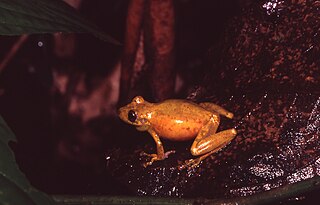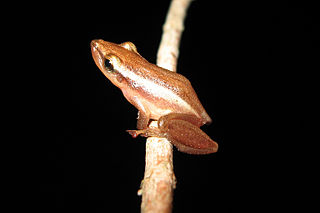
Aplastodiscus cochranae is a species of frog in the family Hylidae. It is endemic to the coastal mountains of Santa Catarina, Brazil. The specific name cochranae honors Doris Mable Cochran, an American herpetologist. Common name canebrake treefrog has been coined for this species.

Scinax alter, the Crubixa snouted treefrog, is a species of frog in the family Hylidae endemic to Brazil.

Scinax boulengeri is a species of frog in the family Hylidae. It is found in Colombia, Costa Rica, Nicaragua, Panama, and possibly Honduras. Its natural habitats are subtropical or tropical moist lowland forests, intermittent freshwater marshes, pastureland, plantations, rural gardens, and urban areas. It has been found as high as 600 meters above sea level.

Scinax cruentomma is a species of frog in the family Hylidae. It is found in the upper Amazon Basin of southern Colombia, eastern Ecuador, northeastern and east-central Peru, and western Brazil; its presence is French Guiana is dispted. The specific name cruentomma is derived from the Greek cruentos meaning "bloody" and omma meaning "eye", referring to the red streak in the eye of this frog. This species is also known as the Manaus snouted treefrog.

Scinax squalirostris is a species of frog in the family Hylidae. It is found in southeastern, southern and central Brazil, Uruguay, northeastern Argentina, southern Paraguay, and Bolivia. The nominal species might actually represent more than one species. Common names striped snouted treefrog and long-snouted treefrog have been coined for it.
Nyctimantis galeata is a species of frog in the family Hylidae. It is endemic to Brazil and only known from its type locality near Morro do Chapéu, Bahia, in the northern part of the Espinhaço Mountains. The specific name galeata is derived from Latin and means "covered with a helmet", in reference to the co-ossified head of this frog.

Scinax tropicalia, or Tropicalia's snouted treefrog, is a frog. Scientists report two distinct populations, both in Atlantic forest in Brazil. It lives no more than 600 meters above sea level.
Scinax imbegue is a frog in the family Hylidae. It is endemic to Brazil. It lives in open-forest plateus no more than 700 meters above sea level.

Scinax tsachila is a frog in the family Hylidae. It is endemic to Ecuador and probably also lives in Peru and Colombia. Scientists have seen from sea level to 1207 meters above sea level. It lives on the Pacific side of the contienent.
Scinax tigrinus is a frog in the family Hylidae. It is endemic to Brazil.
Scinax rupestris, the Veadeiros snouted tree frog, is a species of frog in the family Hylidae. It is endemic to Brazil and has been found in the state of Goiás.
Scinax cabralensis is a frog in the family Hylidae. It is endemic to Brazil. Scientists observed some of these frogs 1070 meters above sea level.

Scinax juncae is a species of frog in the family Hylidae. It is endemic to Brazil.
Scinax sateremawe is a frog in the family Hylidae. It is endemic to Brazil. Scientist know it from its type locality in the Floresta Nacional de Pau-Rosa.
Scinax cretatus is a frog in the family Hylidae endemic to Brazil.
Scinax montivagus is a frog in the family Hylidae. It is endemic to Brazil. It is known solely from its type locality in the Chapada Diamantina in the Espinhaço Range.
Scinax rossaferesae is a frog in the family Hylidae. It is endemic to Brazil and has been observed in the Guartelá Canyon area.
Scinax strussmannae, or Strüssmann’s snouted tree frog, is a frog in the family Hylidae, endemic to dense rainforests in Brazil. It has been found in Nacentes do Lago Jari National Park.
Scinax ruberoculatus, the red-eyed snouted tree frog, is a frog in the family Hylidae. It is endemic to forest habitats in Brazil, Suriname, and French Guiana.
Boana stellae is a frog in the family Hylidae, endemic to Brazil. Scientists know it from the type locality: between 200 and 600 meters above sea level on the Araucaria plateau in Rio Grande do Sul.








